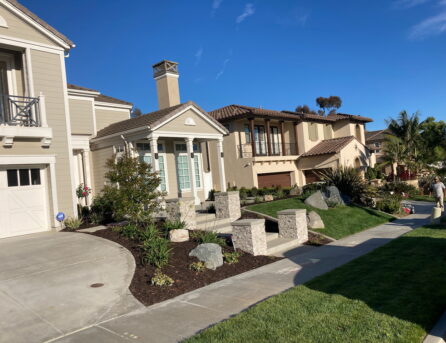
If you’re feeling the strain of rising water bills, you’re not alone. Homeowners across Southern California are looking for smart ways to cut utility costs without sacrificing curb appeal. One of the most effective and environmentally responsible solutions is to install drought-tolerant landscaping.
By redesigning your outdoor space to use less water, you can significantly lower your monthly water bills while also reducing your environmental impact. It’s a win for your wallet and for the plane!
How Drought-Tolerant Landscaping Saves Money
Traditional lawns and high-maintenance gardens often require frequent watering, particularly during the hot summer months. With water rates continuing to rise and drought conditions becoming more common, this can quickly lead to expensive utility bills.
In contrast, drought-tolerant landscaping uses plants that thrive in dry climates and require little irrigation. Once established, these plants need far less water than a typical lawn, which can translate into hundreds of dollars in annual savings. Homeowners who make the switch often see a noticeable reduction in their water bills within just a few months.
Eco-Friendly and Low Maintenance
In addition to helping you save money, drought-tolerant landscaping represents an environmentally responsible choice. It helps conserve water, reduces runoff, and supports native pollinators and wildlife. Many drought-tolerant plants are native to California and are naturally adapted to the local climate, making them more resilient to pests and temperature changes.
These landscapes also require less mowing, fertilizing, and upkeep compared to a traditional lawn, freeing up your time while still keeping your yard attractive and vibrant year-round.
Smart Design with Long-Term Benefits
Creating a drought-tolerant yard does not mean settling for a dull or lifeless landscape. With the help of skilled landscaping contractors in Temecula, you can design a beautiful outdoor space that complements your home’s style and adds value to your property. These professionals can guide you in selecting the right mix of plants, ground covers, and hardscaping features to maximize both function and visual appeal.
Whether you prefer a clean, modern look with succulents and stone pathways or a colorful Mediterranean-inspired garden with lavender and rosemary, we can offer you countless design possibilities that use minimal water.
Consider an Alternative
In addition to low-water plants and drought-tolerant landscaping, artificial turf can be an excellent option for homeowners looking to replace a high-maintenance lawn. Modern synthetic grass offers a lush, green appearance year-round without the need for constant watering, mowing, or fertilizing. It’s an economical and sustainable solution that dramatically reduces water usage and maintenance costs over time, making it a smart complement to eco-friendly landscaping efforts.
Start Saving Today
Switching to drought-tolerant landscaping is one of the most effective ways to cut costs and reduce your environmental footprint. With our expert help, the transition can be smooth and rewarding.
If you’re tired of watching your water bills climb and want a yard that works smarter, not harder, consider reaching out to our experienced landscaping contractors in Temecula. A consultation with us can help you explore your options and take the first step toward a more sustainable and cost-effective outdoor space.
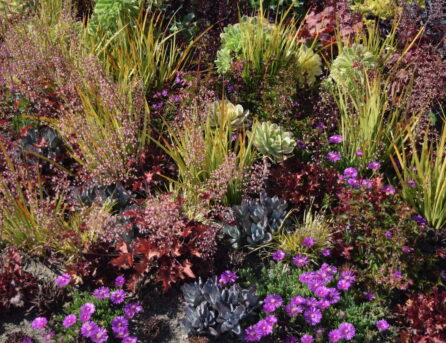
If you are thinking about making your yard more water-efficient, xeriscaping is a smart and sustainable choice. This landscaping method focuses on reducing water use without sacrificing beauty. Xeriscaping has become a popular solution for homeowners who want to conserve resources while still enjoying an attractive outdoor space, especially in dry regions like Southern California,
Here is what you can expect when switching to a drought-tolerant landscape, along with the many benefits this approach offers.
What Is Xeriscaping?
Xeriscaping is a landscaping method that uses drought-tolerant plants and efficient irrigation systems to reduce water use. Instead of relying on large lawns and thirsty plants, xeriscaping incorporates native vegetation, succulents, mulch, rocks, and other low-maintenance features. The result is a landscape that thrives with minimal water while still providing curb appeal and functionality.
Step One: Planning Your New Landscape
The first step in xeriscaping is to work with experienced professionals who understand your local climate and soil. Our landscaping contractors in Temecula are familiar with the needs of Southern California yards and can design a plan that fits your goals, property size, and style preferences.
During the planning stage, your contractor will:
- Assess your current yard layout
- Evaluate sun exposure, drainage, and soil conditions
- Recommend drought-tolerant landscaping options
- Suggest design features such as pathways, rock beds, or seating areas
Step Two: Removing Thirsty Features
Most xeriscaping projects begin by removing or reducing traditional lawns, which are among the most water-hungry elements in residential landscapes. Your landscaping team may also remove plants that are not suited to low-water environments. In their place, they will install mulch, rock, gravel, or other ground covers that help conserve soil moisture and reduce evaporation.
Step Three: Choosing the Right Plants
Xeriscaping does not mean giving up on greenery. You can still enjoy flowers, shrubs, and trees—all carefully selected for their ability to thrive in dry conditions. Common drought-tolerant landscaping plants in Southern California include:
- Lavender
- Agave and aloe
- Sage and rosemary
- Succulents of all shapes and colors
These plants not only require less water but also attract pollinators and support local biodiversity.
Step Four: Installing Efficient Irrigation
Even drought-tolerant plants need some water, especially while getting established. A good xeriscaping plan includes a drip irrigation system that delivers water directly to the roots. These systems use far less water than traditional sprinklers and are easier to control.
Smart irrigation timers and moisture sensors can also help prevent overwatering and keep your plants healthy.
Step Five: Enjoying the Benefits
Once your xeriscaped yard is in place, you will begin to notice the benefits right away. These include:
- Lower water bills
- Less time spent on maintenance
- Fewer weeds and pests
- A beautiful, unique yard that suits the local environment
Over time, your plants will mature and require even less care, giving you more freedom to enjoy your outdoor space without constant upkeep.
Work with Local Experts
Switching to xeriscaping is a worthwhile investment for your home and the environment. Whether you want to replace your entire yard or start with a small area, we can guide you through the process and help you choose the right drought-tolerant landscaping features.
Ready to transform your yard into a water-wise oasis? Give us a call to learn more about xeriscaping and how we can help you create a landscape that saves water and looks great year round.
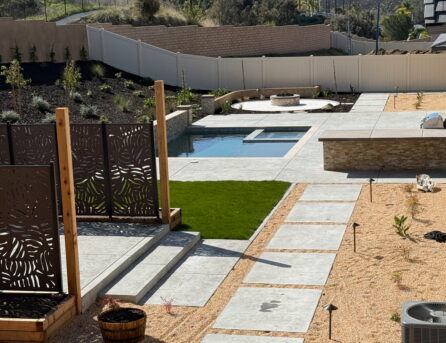
Installing a swimming pool is more than just an investment in your property. It is also an investment in your health and quality of life! A well-designed pool can become the centerpiece of your backyard, offering physical, emotional, and social benefits for years to come. Whether you are looking to boost your fitness, reduce daily stress, or create more time with loved ones, a pool may be exactly what your home needs.
A Healthier Way to Stay Fit
Swimming is one of the most effective full-body workouts available. It improves cardiovascular health, strengthens muscles, and increases flexibility, all while being gentle on the joints. For those with arthritis, injuries, or mobility limitations, water provides resistance without impact, making it ideal for low-stress exercise. Even casual swimming a few times a week can help with weight management and overall fitness.
If you are not a fan of the gym, having a pool just a few steps from your back door can make it easier to stay active. Many homeowners work with our pool contractors in Temecula to build pools that meet their fitness needs, whether that means a traditional lap pool or a custom design that supports aquatic exercise.
Stress Relief in Your Own Backyard
Beyond the physical benefits, pools are a great way to unwind and relax. Floating in water or enjoying a quiet swim can help ease anxiety and tension. The soothing effects of water have been shown to lower cortisol levels and encourage better sleep. At the end of a long day, simply dipping your feet in the pool or listening to the water’s gentle movement can help you mentally recharge.
Creating a peaceful pool environment with plants, lighting, and thoughtful design can further enhance this benefit. Partnering with our landscaping contractors in Temecula can help you build a backyard oasis that promotes relaxation and wellness.
More Time With Family and Friends
Installing a pool is also a wonderful way to bring people together. Families often find that their pool becomes a favorite gathering place, whether it is for an afternoon swim, a weekend barbecue, or a summer party. Kids are more likely to spend time at home when they have a fun and safe place to play, and adults appreciate having an easy way to entertain guests.
Spending time together outdoors strengthens relationships and encourages a more active lifestyle. For households that want to cut back on screen time and enjoy more meaningful moments, a pool provides the perfect setting.
Build the Lifestyle You Want
With the right design and features, a pool can reflect your lifestyle and goals and be tailored to your needs. Experienced pool contractors can help you plan and build the right type of pool, while landscaping contractors can complete the transformation with plants, pavers, seating areas, and lighting.
If you are ready to take the next step in creating a healthier and more enjoyable home environment, reach out to our team to discuss your ideas. Let’s design a custom pool that supports your wellness, brings joy to your family, and enhances the beauty of your backyard.

If you are planning a new landscape or refreshing your existing yard, consider using softscapes to do more than just beautify your home. Thoughtfully chosen plants and garden elements can attract pollinators like bees and butterflies, and also provide food and shelter for birds and other local wildlife. In Southern California’s warm, sunny climate, these additions not only thrive but also support a healthier environment.
Why Pollinators and Wildlife Matter
Pollinators such as bees and butterflies play a vital role in ecosystems by helping plants reproduce. Without them, many fruits, vegetables, and flowering plants would struggle to grow. Birds also contribute by eating pests, dispersing seeds, and enhancing biodiversity in your garden. By designing your landscape to welcome these helpful visitors, you contribute to local ecological balance while creating a vibrant and lively yard.
Choosing the Right Plants
Native plants are one of the best choices when it comes to attracting pollinators. These species are adapted to Southern California’s conditions and provide nectar, pollen, and shelter for local insects and birds. Consider adding the following to your garden design:
- Milkweed: Essential for monarch butterflies, this plant supports their entire life cycle.
- California poppies: These bright flowers are not only drought-tolerant but also attract bees.
- Lavender and salvia: Both are fragrant and beloved by a wide variety of pollinators.
- Manzanita and ceanothus: These shrubs provide shelter for birds and food for pollinators.
- Sunflowers and coneflowers: These bold blooms feed bees and birds alike.
Designing with Wildlife in Mind
Beyond plant selection, your garden layout can help attract and support wildlife. Landscaping contractors in Temecula often recommend layering your garden with trees, shrubs, and groundcover to mimic natural habitats. Adding features like birdbaths, shallow water dishes, and flat stones for butterflies to rest on can make your yard even more inviting.
Avoid using pesticides or herbicides, which can harm beneficial insects and animals. Instead, focus on healthy soil, proper watering, and organic garden care in Temecula to maintain a thriving outdoor space.
A Yard That Gives Back
When you plant with a purpose, your yard becomes more than a visual feature; it becomes a habitat! Watching birds visit your feeders, hearing the buzz of bees around flowering plants, and spotting butterflies fluttering through the garden are all rewarding experiences. These signs of life add movement, sound, and natural beauty to your softscape.
In a time when pollinator populations are declining, small efforts at home can make a big difference. You do not need a large property or a wild garden to contribute. Even small urban yards and patio spaces can be designed to help nature thrive.
Partner with Us for Expert Guidance
If you are ready to create a pollinator-friendly garden that enhances your outdoor space and supports local wildlife, working with experienced professionals can help. Our landscaping contractors can guide you in selecting the right plants and designing a garden that balances beauty and sustainability. For ongoing support, expert garden care in Temecula ensures your plants stay healthy and continue to benefit pollinators for seasons to come.
Want to make your garden a haven for pollinators and birds? Contact our team this spring to start planning a garden that helps nature thrive right in your backyard.
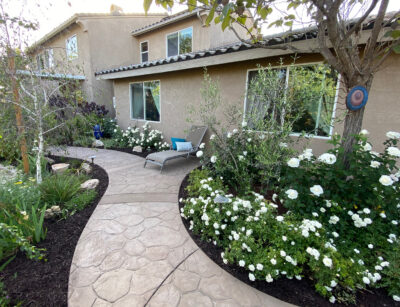
Outdoor living has become a top priority for homeowners, with hardscaping playing a major role in transforming ordinary yards into functional, stylish extensions of the home. Whether you’re updating a patio or redesigning your entire landscape, staying on top of current hardscape trends can help you create a backyard that feels modern, inviting, and uniquely yours.
Here, we take a look at the latest styles and design features gaining popularity in 2025—and why now might be the perfect time to partner with experienced concrete contractors in Temecula to bring your vision to life.
1. Modern Concrete Finishes
Gone are the days of plain gray slabs. Today’s concrete patios and walkways feature creative textures, patterns, and finishes. Popular options include:
- Stamped concrete that mimics natural stone or brick.
- Smooth, polished concrete for a clean, minimalist look.
2. Mixed Materials and Textures
Combining materials adds depth and interest to outdoor spaces. A patio that features both stone and wood accents or concrete paired with metal creates visual contrast and modern flair. These combinations can define spaces like dining areas, fire pit zones, or pathways with subtle elegance.
3. Large Format Pavers
Oversized concrete or porcelain pavers are trending thanks to their sleek look and easy maintenance. These create a spacious, contemporary feel, especially when installed with narrow seams or in grid patterns. They also work well in both modern and transitional landscape designs.
4. Natural Stone with Rustic Appeal
On the other side of the spectrum, natural stone remains a timeless choice—especially for those who love a warm, rustic, or Mediterranean aesthetic. Flagstone patios, stacked stone walls, and boulder accents bring a grounded, earthy feel to your landscape.
5. Fire and Water Features
Hardscaping isn’t just about surfaces—features like fire pits, fireplaces, and fountains are now must-have elements. These additions add ambiance, extend usability into cooler months, and serve as natural focal points.
6. Built-In Seating and Planters
Integrated benches and raised planter beds not only maximize space but also create seamless design flow. Concrete or stone seating can be wrapped around fire pits or walls, while built-in planters soften hardscapes with pops of greenery.
7. Sustainable Hardscape Choices
Eco-conscious landscaping is growing in importance. Permeable pavers help reduce runoff, while recycled materials offer green alternatives without sacrificing style. Durable materials like concrete and stone also reduce the need for frequent replacements.
8. Outdoor Kitchens and Dining Areas
With the rise of staycations and home entertaining, full outdoor kitchens are becoming a staple. Hardscaped areas with built-in grills, countertops, and dining space increase functionality and boost property value.
Your outdoor space is an investment, so make it one you’ll enjoy for years to come. Whether your style leans sleek and modern or cozy and rustic, teaming up with top-tier landscape contractors in Temecula ensures your hardscaping project is built with quality, precision, and vision.
If you’re ready to update your patio or outdoor living space, give us a call to start planning your dream landscape.
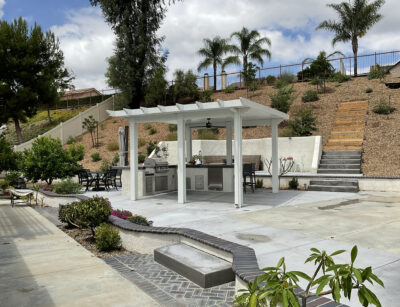
Who says outdoor cooking has to be a summer-only activity? With the right setup, you can enjoy your BBQ area all year long, no matter the season. By incorporating the right elements into your design, you can create a space that’s as functional in December as it is in July.
If you’re ready to turn your dreams into reality, working with experienced outdoor kitchen designers can help you build a durable and stylish area designed for year-round use.
1. Add Heating for Cooler Months
Even in Southern California, evening temperatures can dip during fall and winter. To keep your BBQ area cozy:
- Install built-in patio heaters or freestanding propane heaters.
- Consider a gas fireplace as both a heating element and design centerpiece.
- Add heated flooring beneath concrete or stone patios for added comfort.
2. Build Weather-Resistant Shade Structures
Overhead protection is crucial for year-round use. Pergolas, pavilions, or retractable awnings can shield you from sun and rain alike. Consider insulated roofing panels to provide better temperature control and UV protection. For extra versatility, opt for motorized shades or enclosures to block wind or add privacy.
3. Choose All-Weather Materials
From countertops to cabinets, your BBQ station should feature materials that can withstand the elements:
- Use stainless steel or weatherproof stone for your grill area and prep space.
- Choose sealed, fade-resistant pavers or concrete for flooring.
- Install cabinets made from marine-grade polymer or other moisture-resistant materials.
4. Incorporate Lighting and Electrical
With proper lighting, you won’t need to cut your cooking short after sunset:
- Install task lighting around grills and prep areas.
- Add ambient lighting such as string lights, lanterns, or built-in LED fixtures for atmosphere.
- Ensure weatherproof outlets are available for appliances, music systems, or additional heaters.
5. Design for Comfort and Convenience
To make your BBQ area a go-to hangout spot year-round:
- Include comfortable seating with cushions made from outdoor-rated fabric.
- Set up a mini fridge, sink, or storage to reduce trips indoors.
- Add ceiling fans for air circulation during the warmer months.
Extend Your Outdoor Living Experience
Your backyard BBQ zone can be the ultimate year-round gathering space with the right planning and upgrades. Whether you’re grilling steaks in summer or roasting marshmallows in winter, functionality and comfort go hand in hand. Partnering with skilled landscape contractors in Temecula ensures your outdoor cooking area is designed for every season—and built to last.
Let’s bring your outdoor kitchen vision to life. Contact us to discuss your outdoor kitchen dreams, and together we’ll start planning your four-season BBQ retreat.
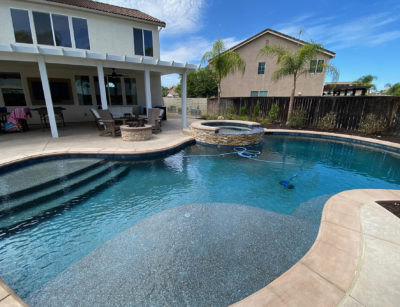
Transforming your backyard pool area into a luxurious private oasis is easier than you think! With thoughtful landscaping and hardscaping elements, you can elevate your backyard into a resort-style retreat that’s perfect for relaxation and entertaining. Whether you’re updating an existing space or starting from scratch, use these ideas to inspire your outdoor makeover.
1. Create a Seamless Pool Deck
Your pool deck is the foundation of your poolside experience. Consider materials like stamped concrete, natural stone, or pavers to create a durable and visually appealing surface. Choose colors and textures that complement your home and pool design, and add non-slip finishes for safety.
2. Add a Fire Pit or Outdoor Fireplace
A fire feature brings warmth, ambiance, and functionality to your backyard. A built-in fire pit or stone fireplace near the pool provides a cozy gathering spot for cooler evenings and extends the usability of your space year-round.
3. Incorporate Strategic Lighting
Outdoor lighting enhances both the beauty and safety of your pool area. Use pathway lights, spotlights, or LED strip lighting to highlight landscaping features and architectural elements. Underwater lights in the pool add drama and make night swimming more enjoyable.
4. Embrace Lush Greenery and Native Plants
Softening your hardscape with greenery makes the space feel inviting and luxurious. Choose low-maintenance, drought-tolerant plants that thrive in the Temecula climate. Consider planting palms, ornamental grasses, or succulents to bring texture and color without excessive water use.
5. Add Shade Structures and Lounge Zones
Provide comfort and style with pergolas, shade sails, or umbrellas. These structures offer sun protection and define spaces for lounging or dining. Incorporate comfortable seating like cushioned loungers or outdoor sectionals to encourage relaxation.
6. Enhance Privacy
Create a sense of seclusion with privacy screens, trellises with climbing plants, or tall shrubs. These features not only add to the visual appeal but also make your backyard feel more exclusive and tranquil.
7. Blend Water Features
Adding a small waterfall, fountain, or spa spillway enhances the sensory experience of your pool area. The sound of running water contributes to a relaxing ambiance and adds a dynamic visual element to your landscape design.
Bringing It All Together
A beautifully designed pool area isn’t just about aesthetics—it’s about creating a space that reflects your lifestyle and provides lasting enjoyment. If you’re looking to elevate your outdoor living with professional landscaping in Temecula, working with experienced designers can help bring your dream backyard to life.
Contact our team of pool contractors in Temecula to explore custom landscaping and hardscaping solutions tailored to your pool and property.
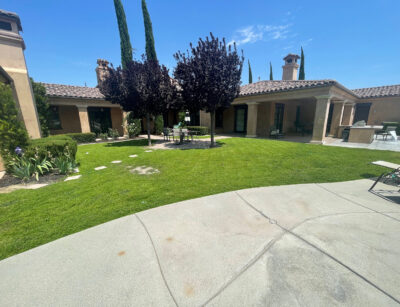
If you’re looking for an eco-friendly, low-maintenance alternative to traditional lawns, Kurapia is a groundcover worth considering. Known for its drought resistance and ability to thrive in a variety of climates, Kurapia is becoming a go-to choice for sustainable landscaping in Temecula and other water-conscious regions.
This step-by-step guide will help you successfully plant and care for Kurapia to achieve a beautiful, green landscape.
Step 1: Site Preparation
Start by clearing the area of any existing weeds, grass, or debris. Level the soil as needed and test for proper drainage. If the soil is compacted or clay-heavy, consider tilling and adding compost or sand to improve aeration and drainage.
Step 2: Soil Amendment and Irrigation Setup
Although Kurapia is low maintenance, it does best in well-draining soil with moderate nutrients. Apply a balanced, slow-release fertilizer before planting. Install an efficient irrigation system such as drip lines or low-spray heads to provide consistent moisture during establishment.
Step 3: Planting Kurapia Plugs
Kurapia is typically planted using plugs spaced 12 to 18 inches apart. Plant the plugs in a grid pattern for even coverage and faster fill-in. Water the plugs thoroughly after planting.
Step 4: Initial Watering Schedule
For the first 4 to 6 weeks, keep the soil consistently moist but not waterlogged. This encourages strong root development. After establishment, Kurapia requires significantly less water than traditional turfgrass.
Step 5: Mowing and Maintenance
Once your Kurapia has filled in, you can mow it every 4 to 6 weeks if you prefer a uniform appearance. It doesn’t grow tall, so mowing is optional. Remove weeds manually or spot-treat as needed, especially during the early stages of growth.
Step 6: Long-Term Care
Kurapia thrives with minimal care. In most cases, it requires little to no fertilization after the first year. Periodic watering during extreme drought and seasonal mowing will keep it looking vibrant.
Why Choose Kurapia?
- Drought Tolerance; ideal for areas with water restrictions
- Low Maintenance; minimal mowing and fertilizing
- Durability and Density; withstands foot traffic once established
- Eco-Friendliness; helps reduce water and chemical usage
Whether you’re updating your front yard or rethinking commercial landscaping in Temecula, Kurapia offers a sustainable and attractive solution. Its soft, green texture and easy upkeep make it an excellent alternative to water-hungry lawns.
Ready to transform your landscape? Reach out to our landscape design team for advice, planting services, or to schedule a consultation.
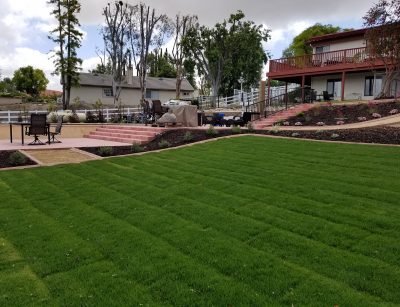
A lush, green lawn is a hallmark of well-maintained landscaping in Temecula, but pests can quickly turn it into a patchy, unhealthy mess. Southern California’s warm climate creates the perfect environment for lawn pests like grubs, chinch bugs, and armyworms, which can cause extensive damage if left unchecked. Here’s how to identify, prevent, and treat common lawn pests to keep your yard looking its best.
Identifying Common Lawn Pests
- Grubs – These white, C-shaped larvae feed on grassroots, causing brown patches and loose turf that lifts easily.
- Chinch Bugs – Tiny black bugs with white wings, chinch bugs suck moisture from grass blades, creating yellow or brown dead spots.
- Armyworms – These caterpillars chew through grass, leaving behind bare patches and ragged edges on grass blades.
Preventing Lawn Pest Infestations
- Maintain a Healthy Lawn – Proper watering, mowing, and fertilization strengthen grass, making it more resistant to pests.
- Dethatch and Aerate – Thick thatch layers provide hiding spots for pests. Aerating the soil improves drainage and root health.
- Encourage Beneficial Insects – Ladybugs and nematodes are natural predators of lawn pests and help keep populations in check.
Treating Lawn Pests Effectively
- Grub Treatment – Apply beneficial nematodes or grub control products in late summer when grubs are most active.
- Chinch Bug Control – Use insecticidal soap or natural predators like lacewings to reduce infestations.
- Armyworm Treatment – Introduce Bacillus thuringiensis (Bt), a safe bacterial treatment that targets caterpillars.
Keep Your Lawn Pest-Free Year-Round
Regular monitoring and proactive lawn care and maintenance in Temecula can help prevent severe pest damage. If you notice persistent issues, consider consulting a lawn care professional for targeted treatment options. Call us for expert lawn care solutions and keep your Southern California lawn thriving.
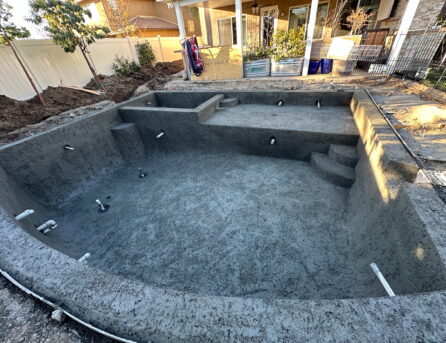
A custom swimming pool is more than just a backyard addition—it’s an investment in your home, lifestyle, and outdoor enjoyment. Whether you’re dreaming of a resort-style oasis or a sleek, modern lap pool, understanding the construction process will help you make informed decisions. Here’s a step-by-step guide to what you can expect from start to finish.
Step 1: Planning and Design
The first phase involves meeting with a pool designer to discuss your vision, space, and budget. This step includes:
- Choosing the pool’s size, shape, and features
- Deciding on materials and finishes
- Reviewing zoning laws and obtaining necessary permits
Step 2: Excavation and Framing
Once the design is finalized, the construction team begins excavation. This includes:
- Digging out the pool area
- Installing a structural framework (rebar or steel)
- Preparing for plumbing and electrical work
Step 3: Plumbing and Electrical Installation
Professional plumbers and electricians install:
- Pool filtration and circulation systems
- Lighting and heating components
- Optional features like waterfalls or jets
Step 4: Shotcrete or Gunite Application
This phase involves spraying the pool shell with either shotcrete or gunite, which hardens into a durable foundation.
Step 5: Tile, Coping, and Decking
Once the pool structure is set, aesthetic details are added:
- Tile and coping for the pool’s edge
- Decking materials such as concrete, stone, or pavers
- Landscaping to enhance the pool area
Step 6: Interior Finish and Water Fill
The final stage includes applying a plaster, pebble, or quartz finish to the interior and filling the pool with water.
Step 7: Final Inspection and Start-Up
A professional will inspect the pool, balance the chemicals, and ensure all systems function properly.
Step 8: Landscaping Around Pool
To fully integrate your new swimming pool with your landscape, you might wish to add additional elements. A landscape construction team can assist you with finishing out your dream oasis. Luckily, we offer both swimming pool design and landscaping design services, making us your one-stop shop for designing and building the perfect backyard.
Ready to Build Your Dream Pool?
Creating a custom pool is an exciting process that transforms your backyard into a personal retreat. If you’re ready to start your project, contact our pool contractors in Temecula to discuss your vision and get expert guidance.
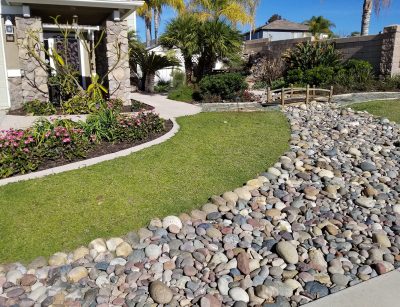
For homeowners and businesses looking to create a lush, green landscape without excessive water consumption, Kurapia is a game-changing alternative to traditional grass. This incredibly hardy ground cover is gaining popularity for its low-maintenance, eco-friendly, and resilient qualities, making it an ideal choice for drought-tolerant landscaping.
What Is Kurapia?
Kurapia is a drought-resistant ground cover that resembles traditional grass but requires significantly less water. Originally developed in Japan, this innovative turf alternative thrives in various climates, from hot and dry regions to cooler environments. Unlike conventional lawns that demand frequent irrigation, Kurapia can flourish with up to 60% less water, making it an excellent choice for drought-conscious landscapes.
Benefits of Kurapia
- Extreme Drought Tolerance – Perfect for regions with water restrictions, Kurapia remains green and healthy even during dry seasons.
- Low Maintenance – Unlike traditional grass, Kurapia requires minimal mowing and fertilization.
Strong Root System – Its deep roots enhance soil stability, preventing erosion and making it ideal for sloped landscapes. - Pest and Disease Resistant – Naturally resilient, Kurapia reduces the need for pesticides and chemical treatments.
- Versatile and Durable – Thrives in various soil conditions and can withstand heavy foot traffic, making it suitable for both residential and commercial properties.
How Does Kurapia Compare to Traditional Grass?
Compared to traditional grass, Kurapia requires up to 60 percent less water. It only needs to be mowed once or twice per year, holds up better to foot traffic, and has a higher disease and pest resistance.
Is Kurapia Right for Your Landscape?
If you want to maintain a beautiful, eco-friendly lawn without excessive upkeep, Kurapia is a fantastic solution. Whether you’re designing a low-maintenance backyard, commercial space, or public park, this versatile turf alternative helps conserve water while keeping your landscape vibrant year-round.
Start Your Drought-Tolerant Landscape Before Summer!
Switching to Kurapia is a smart investment in sustainability, cost savings, and long-term beauty, making it an excellent choice for landscaping in Temecula. If you’re interested in replacing your lawn with this innovative ground cover, give us a call to discuss your needs.
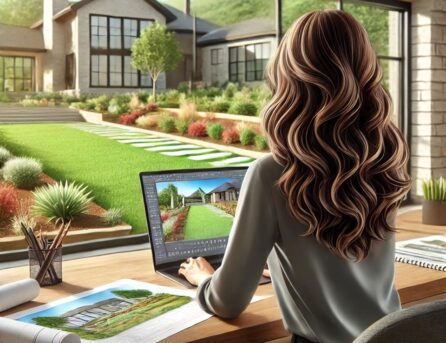
A beautifully designed landscape does more than enhance curb appeal—it creates an outdoor space that is functional, sustainable, and tailored to your lifestyle. While hiring a general landscaper can help with basic maintenance and installations, a professional landscape designer brings expertise and creativity to transform your outdoor area into a cohesive, well-planned environment.
What Sets a Landscape Designer Apart?
Unlike a regular landscaper who primarily focuses on installation and upkeep, a landscape designer has specialized training and a strategic approach to outdoor planning. Here’s what makes them unique:
- Formal Education & Certification – Many landscape designers hold degrees or certifications in landscape architecture, horticulture, or environmental design.
- Site Analysis & Planning – A professional designer evaluates factors like soil quality, drainage, climate, and topography to create a plan that works in harmony with the environment.
- Design Expertise – They consider aesthetics, functionality, and sustainability to craft a layout that complements your property’s architecture and personal style.
- Plant Knowledge – With extensive knowledge of plant species, a designer selects plants that thrive in your region while ensuring seasonal beauty and low maintenance.
- Hardscape & Outdoor Living Solutions – Designers incorporate patios, walkways, retaining walls, and outdoor kitchens with proper planning for durability and style.
- Budget & Project Management – They help manage costs, source quality materials, and coordinate with contractors to ensure a seamless installation process.
Benefits of Hiring a Landscape Designer
- Customized Design – Every yard is unique, and a designer tailors the layout to fit your preferences, lifestyle, and the natural elements of your property.
- Increased Property Value – A well-planned landscape can boost your home’s resale value and create a lasting impression.
- Efficient Space Utilization – Whether you have a small backyard or acres of land, a designer maximizes functionality and flow.
- Eco-Friendly Practices – Water-efficient irrigation, native plant selections, and sustainable materials help reduce environmental impact.
- Long-Term Cost Savings – Proper planning minimizes costly mistakes, such as poor plant choices or drainage issues, which can lead to expensive fixes down the road.
Transform Your Outdoor Space with a Professional Touch
A landscape designer brings a visionary approach to outdoor spaces, ensuring they are not only beautiful but also functional and sustainable. If you want to elevate your yard with expert planning and creativity, consider working with a professional landscape designer.
Contact us today to discuss your goals for landscaping design in Temecula and bring your outdoor vision to life!
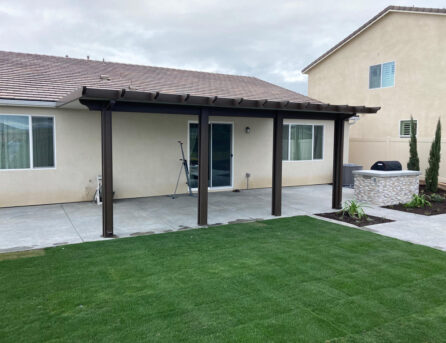
Southern California’s warm climate and low rainfall make choosing the right grass essential for maintaining a lush, green lawn. Homeowners need grass varieties that can withstand heat, drought conditions, and occasional foot traffic while still looking good year-round. The right choice can reduce water usage and simplify lawn care and maintenance. Let’s discuss two of the best grass types suited for Southern California lawns.
Bermuda Grass
Bermuda grass is a warm-season turfgrass that is prized for its durability, rapid growth, and superior drought tolerance. It thrives in full sun and has a fine texture, forming a dense, carpet-like lawn that is both visually appealing and highly functional. This grass is particularly well-suited for high-traffic areas, making it a popular choice for sports fields, golf courses, and residential lawns in hot, sunny climates.
One of Bermuda grass’s key strengths is its ability to recover quickly from wear and tear. Its aggressive growth pattern allows it to spread rapidly through stolons (above-ground runners) and rhizomes (underground stems), which means damaged areas can fill in quickly. Despite its fast growth, we find that we only need to mow Bermuda grass once per week, making it a reasonable choice for those who wish to avoid an overly demanding lawn.
Since Bermuda grass is a warm-season grass, it thrives in temperatures between 75°F and 95°F. However, once temperatures drop in the late fall and winter, Bermuda grass enters dormancy, turning brown or straw-colored until warmer temperatures return in the spring. At this time irrigation needs drop, so you can save money on annual water usage.
Homeowners who want a year-round green lawn may decide to overseed with a cool-season grass, such as ryegrass, in the fall. Additionally, Bermuda grass struggles in shaded areas, so if your yard has large trees or structures blocking sunlight, another grass type may be a better fit.
Tall Fescue
Tall fescue is a cool-season grass that remains green year-round in moderate climates, making it an attractive choice for homeowners who want a consistently lush lawn. Unlike Bermuda grass, tall fescue has a coarse texture and grows in clumps, rather than spreading through stolons or rhizomes. However, that also means Fescue cannot self-heal the way Bermuda grass does, so you will need to overseed or damaged bare spots.
While Fescue does best in full sun, it is also more shade-tolerant than Bermuda grass, making it a good option for yards with trees or buildings that block sunlight.
One of the biggest advantages of tall fescue is its deep root system, which allows it to withstand periods of drought better than many other cool-season grasses. This deep rooting also helps with erosion control on slopes or uneven terrain. It also needs less frequent fertilization, making it a lower-maintenance option for homeowners looking for a hardy, adaptable lawn.
Unlike Bermuda grass, which goes dormant in winter, tall fescue stays green year-round in mild climates like those found in Southern California. However, in regions with hot summers like ours, tall fescue may struggle in extreme heat and require additional watering to maintain its color and health. If temperatures rise too high for prolonged periods, it may enter a state of summer dormancy, temporarily browning until cooler temperatures return.
Which Grass is Best for Your Lawn?
If you want a drought-tolerant, high-traffic lawn and don’t mind regular maintenance, Bermuda grass is a great choice—especially for sunny, open areas. However, if you prefer a shade-tolerant, and year-round green lawn, then tall fescue is the better option. In our experience, each type of grass requires about the same amount of mowing.
If you’re unsure which grass type is best for your yard, consulting with our landscape designers in Temecula. We can help you make the right choice based on your soil type, sun exposure, and lawn usage needs. With the right grass variety, you can enjoy a vibrant and resilient lawn that enhances your outdoor space.
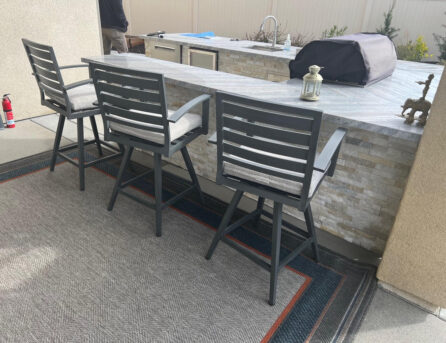
Grilling is more than just a cooking method—it’s an experience. Whether you’re hosting a backyard cookout or preparing a family meal, having the right BBQ accessories and gadgets can elevate your grilling game. These tools will enhance your outdoor kitchen setup and make grilling easier, safer, and more enjoyable.
1. Digital Meat Thermometer for Perfect Doneness
One of the most essential BBQ tools is a high-quality digital meat thermometer. Achieving the perfect temperature ensures juicy steaks, tender chicken, and safe-to-eat meats. Wireless thermometers with Bluetooth connectivity allow you to monitor your food’s temperature in real-time, so you never have to worry about overcooking or undercooking again.
2. Grill Lights for Nighttime Cooking
Even the best outdoor kitchens need proper lighting. If you enjoy grilling in the evening, a good set of grill lights is a must. LED clip-on lights attach directly to your grill, providing bright illumination so you can see your food clearly. Some models even have motion sensors or adjustable brightness settings to enhance visibility.
3. Cast Iron Grill Grates for Superior Searing
Upgrading to cast iron grill grates can take your BBQ results to the next level. Cast iron retains heat better than standard stainless steelstainless-steel grates, giving you better sear marks and enhanced flavor. These grates are also more durable and can withstand high temperatures, making them a worthwhile investment.
4. Grill Baskets for Vegetables and Seafood
If you love grilling vegetables, fish, or shrimp, a grill basket is a game-changer. These perforated metal baskets allow heat and smoky flavors to infuse your food while preventing smaller items from falling through the grates. They’re perfect for grilling delicate foods that might otherwise stick or break apart.
5. BBQ Tool Set for Effortless Grilling
A well-equipped BBQ tool set should include a sturdy spatula, tongs, meat forks, and a basting brush. Look for stainless steel tools with heat-resistant handles for durability and comfort. Some sets even come with a carrying case, making them great for tailgating or camping.
6. Smoker Box for Infusing Wood-Fired Flavor
Want to add rich, smoky flavor to your grilled meats? A smoker box filled with wood chips is the perfect addition to gas or charcoal grills. Hickory, mesquite, applewood, and cherry wood chips each provide distinct flavors that can enhance your BBQ creations.
For expert advice on designing the ultimate backyard grilling space, consult our landscape contractors in Temecula who specialize in custom outdoor kitchens. With the right setup and accessories, you’ll be well on your way to grilling like a pro!

A lack of space doesn’t mean you have to miss out on the luxury of a backyard pool. With smart design choices and innovative features, even a compact pool can become the centerpiece of your outdoor space. These ideas can help you make a big impact with small-scale pool construction in your backyard.
1. Plunge Pools: The Perfect Small-Space Solution
Plunge pools are a fantastic option for homeowners who want to enjoy the benefits of a pool without requiring a large footprint. These small, deep pools are ideal for cooling off on hot days and can even include spa-like features such as built-in seating or hydrotherapy jets. Their compact size also makes them more affordable to install and maintain.
2. Lap Pools for Narrow Yards
If you have a long and narrow backyard, a lap pool is a great way to maximize space while still providing a functional swimming area. These sleek, rectangular pools are designed for exercise and relaxation, fitting neatly along the side of a home or within a narrow garden space. By incorporating an infinity edge or a sleek modern finish, you can enhance the visual appeal of the pool while keeping it practical.
3. Custom Shapes for a Unique Look
When space is limited, opting for a custom-shaped pool can help you make the most of your available area. Freeform pools, kidney-shaped designs, or even corner pools can be tailored to fit your backyard’s layout while creating a natural and inviting ambiance. Working with our experienced landscape contractors in Temecula can ensure that your pool is seamlessly integrated into your outdoor environment.
4. Multi-Functional Features for Maximum Use
Adding features like a tanning ledge, built-in seating, or a raised spa section can make your small pool more versatile. A combination pool and spa setup allows for year-round enjoyment, while a water feature such as a waterfall or bubbling fountain adds a sense of tranquility. LED lighting can also enhance the space, making it a stunning focal point in the evening.
5. Stylish Surroundings to Enhance Your Pool
The area around your pool is just as important as the pool itself. Incorporate stylish decking, lush greenery, and modern hardscaping to create a cohesive and visually appealing outdoor retreat. Thoughtful landscaping can make a small pool feel like a luxurious escape.
No matter the size of your backyard, the right pool construction approach can transform your space into a stunning oasis. Let’s discuss your ideas in depth, and we’ll help you plan the swimming pool of your dreams. With careful planning and creative design, even a small pool can make a big impact.

Retaining walls are more than just functional structures designed to prevent soil erosion—they can also enhance the beauty and usability of your outdoor space. Whether you’re looking to create a tiered garden, define entertainment areas, or add dimension to your yard, a well-designed retaining wall can transform your landscape. Here are some stylish and creative ways to integrate retaining walls into your outdoor design.
1. Multi-Level Terracing for Visual Interest
If your property has a slope, multi-level concrete retaining walls can help turn an unusable hill into a stunning, functional space. By creating terraced levels, you can incorporate garden beds, seating areas, or pathways that blend seamlessly into the landscape. This design not only improves the aesthetic appeal of your yard but also prevents soil erosion and improves drainage.
2. Built-In Seating for Entertaining Spaces
For homeowners who love to entertain, incorporating built-in seating into retaining walls is a stylish and practical choice. A curved concrete retaining wall can double as a bench around a fire pit or outdoor dining area, providing extra seating without taking up additional space. Adding decorative cushions or stone veneer finishes can soften the look and make the space more inviting.
3. Raised Garden Beds for a Modern Look
Concrete retaining walls can also serve as raised garden beds, allowing you to showcase flowers, succulents, or even an herb garden. Raised beds not only add dimension to your landscape but also make gardening easier by reducing the need to bend over. Choosing a smooth or textured concrete finish can complement your home’s architectural style for a cohesive design.
4. Water Features for a Luxury Feel
Enhance the tranquility of your outdoor space by integrating a water feature into your retaining wall. A cascading waterfall built into a concrete wall can create a soothing ambiance while serving as a focal point in your backyard. This feature works well in modern landscapes and can be paired with LED lighting for added nighttime appeal.
5. Decorative Concrete Finishes for Style
Concrete retaining walls don’t have to be plain. Stamped or stained concrete can mimic the look of natural stone, brick, or wood while maintaining the strength and longevity of concrete. Our landscape designers in Temecula can help you choose custom finishes that complement your outdoor aesthetic, creating a beautiful yet durable feature for your yard.
Whether you need a functional erosion solution or a stylish backyard upgrade, concrete retaining walls offer endless design possibilities. Give us a call to discuss your vision, and we can help you make it a reality. With the right approach, you can enhance both the beauty and functionality of your outdoor space.
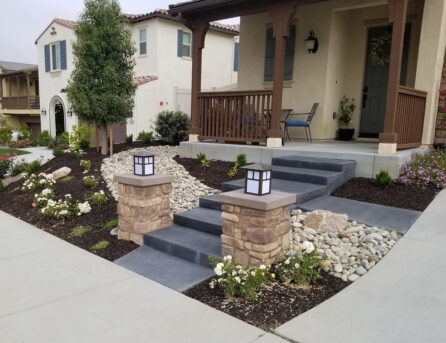
As climate concerns and water conservation remain a priority, homeowners are increasingly turning to drought-tolerant landscaping to create stunning, sustainable outdoor spaces. The year 2025 is shaping up to be a transformative one for landscape design, with innovative trends that balance aesthetics, functionality, and eco-friendliness. Here’s a look at some of the top drought-tolerant landscape trends to watch out for this year.
1. Vertical Gardens for Small Spaces
Urban homeowners and those with limited yard space are embracing vertical gardens as a way to bring greenery to their outdoor spaces. These installations, which use walls or freestanding structures to grow plants, are perfect for drought-tolerant landscapes. Succulents, air plants, and even herbs thrive in vertical arrangements, offering a space-saving solution that’s both practical and visually appealing.
2. Edible Landscaping with a Water-Wise Twist
Edible landscaping is gaining traction as homeowners look for ways to grow their own food while conserving water. Incorporating drought-resistant fruits, vegetables, and herbs—such as rosemary, lavender, figs, and pomegranates—adds functionality to outdoor spaces without compromising on water efficiency. Landscape contractors are designing creative layouts that seamlessly blend edible plants with ornamental ones, resulting in gardens that are both beautiful and productive.
3. Modern Succulent Displays
Succulents continue to dominate the world of drought-tolerant landscaping, but 2025 brings a modern twist. Designers are incorporating geometric arrangements, monochromatic palettes, and striking planters to elevate succulent gardens. Whether used as a focal point in the yard or as accents along pathways, these hardy plants add a sleek, contemporary vibe to any space.
4. Hardscaping with Natural Elements
Hardscaping is evolving to complement drought-tolerant landscapes. Homeowners are opting for permeable pavers, gravel pathways, and natural stone patios to reduce water use while enhancing outdoor functionality. Paired with CA – friendly plants and minimalist designs, these elements create serene, low-maintenance environments that are perfect for relaxing and entertaining.
The Role of Professionals in Drought-Tolerant Design
Creating a drought-tolerant landscape that is both functional and stylish requires careful planning and expertise. Landscape contractors play a vital role in helping homeowners select the right plants, design layouts, and implement sustainable practices. With their guidance, you can transform your outdoor space into a modern, water-wise haven.
Ready to bring these 2025 landscaping trends to your yard? Give us a call so that we can help you design a stunning drought-tolerant landscape that perfectly suits your style and needs.
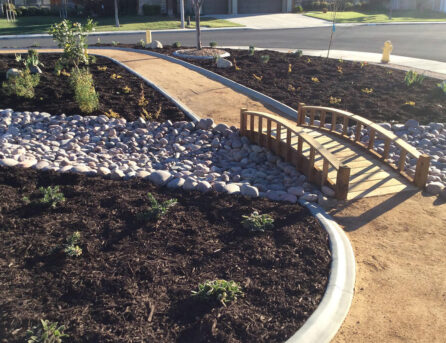
When most people think of concrete, they imagine basic driveways, sidewalks, or foundations. However, concrete has evolved far beyond its utilitarian origins to become a versatile and stylish material in landscape design. From decorative pathways to stunning outdoor seating areas, concrete offers countless creative possibilities for transforming your outdoor space.
1. Decorative Pathways and Patios
Gone are the days of plain gray slabs. Colored and stamped concrete can mimic the look of natural stone, brick, or tile, providing an elegant and durable surface for pathways and patios. This allows homeowners to achieve a high-end look at a fraction of the cost of traditional materials. Concrete pathways can also be designed in unique shapes, curves, or patterns to add a touch of personality to your yard.
2. Custom Retaining Walls
Retaining walls are not just functional; they can also serve as a design element in your landscape. Landscape contractors can create custom retaining walls that blend seamlessly with your yard’s aesthetic. Options like textured concrete or walls embedded with LED lighting can add both beauty and functionality to your outdoor space.
3. Outdoor Fire Features
Concrete is an excellent material for building fire pits and fireplaces. It’s heat-resistant, durable, and can be molded into virtually any shape or size. Whether you’re looking for a cozy fire pit for roasting marshmallows or a grand outdoor fireplace for entertaining, concrete offers endless design possibilities.
4. Built-In Seating and Planters
For a sleek and modern look, consider integrating built-in seating and planters into your landscape using concrete. These features can be customized to suit your style and needs, providing functional and attractive elements that elevate your outdoor living space. Pairing concrete seating with plush cushions or surrounding planters with vibrant greenery can create a striking contrast.
5. Water Features
From fountains to waterfalls, concrete is a popular choice for crafting water features that add tranquility and elegance to your yard. Concrete can be molded into intricate designs, allowing for personalized water elements that complement your overall landscape.
6. Concrete Countertops for Outdoor Kitchens
Outdoor kitchens have become a sought-after feature for many homeowners, and concrete countertops are an excellent addition. They’re durable, weather-resistant, and can be
customized with colors, textures, or inlays to match your design vision. Landscape contractors can work with concrete specialists to ensure your outdoor kitchen is both functional and beautiful.
7. Modern Sculptures and Accents
Concrete can be used to create bold and modern sculptures, garden ornaments, or accent pieces. These artistic touches can serve as focal points in your landscape, adding depth and interest to the overall design.
Why Choose Concrete?
Concrete’s durability, affordability, and versatility make it an ideal material for a wide range of landscape projects. It’s also low-maintenance and can withstand the elements, ensuring your investment lasts for years to come.
If you’re ready to explore the creative potential of concrete in your landscape design, contact our concrete contractors to discuss your ideas. Let us help you transform your outdoor space into a functional and stylish retreat.
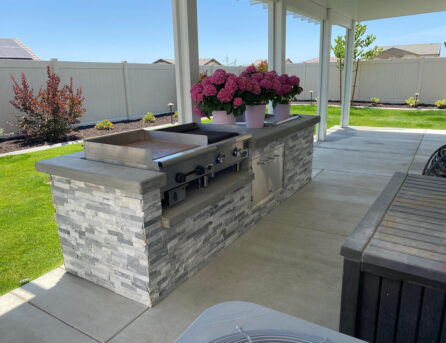
Outdoor kitchens have become a sought-after feature for homeowners looking to enhance their outdoor living spaces. From hosting summer barbecues to creating a cozy ambiance for evening dinners, an outdoor kitchen can elevate your home’s functionality and appeal. However, bringing this vision to life requires careful planning and expertise, which is why hiring professional landscape contractors and outdoor kitchen designers is a smart choice.
Why Work with Professionals?
1. Expert Design and Functionality
Creating an outdoor kitchen isn’t as simple as placing a grill and a few chairs in your backyard. It involves designing a space that seamlessly integrates appliances, counter space, seating, and aesthetic elements. Professional outdoor kitchen designers bring a wealth of experience in crafting layouts that are both functional and visually stunning. They can help you maximize your space, ensure proper ventilation, and incorporate features that suit your lifestyle, such as a pizza oven or a built-in beverage cooler.
2. Access to High-Quality Materials
One of the challenges of building outdoor kitchens is selecting materials that can withstand the elements while maintaining their beauty. Professional landscape contractors have access to durable, high-quality materials and know which ones are best suited for outdoor use. They can guide you in choosing weather-resistant countertops, cabinets, and flooring that will stand the test of time.
3. Seamless Integration with Landscaping
A well-designed outdoor kitchen should blend harmoniously with your overall landscape. Landscape contractors have the expertise to incorporate your outdoor kitchen into the larger design of your yard, ensuring a cohesive look. Whether it’s adding a pergola for shade, installing outdoor lighting, or surrounding the space with lush greenery, they can create a unified and inviting outdoor oasis.
4. Time and Cost Efficiency
While it may seem tempting to tackle an outdoor kitchen as a DIY project, it can quickly become overwhelming. Professionals bring the tools, skills, and experience needed to complete the job efficiently and correctly the first time. This saves you time and helps you avoid costly mistakes or repairs down the road.
5. Compliance and Safety
Outdoor kitchens often require electrical, plumbing, and gas line installations, which come with strict building codes and safety considerations. Professional contractors are familiar with local regulations and ensure that your kitchen meets all necessary requirements, giving you peace of mind.
Invest in Quality and Expertise
An outdoor kitchen is a significant investment that can transform your outdoor space and add value to your home. By hiring professional outdoor kitchen designers, you can ensure that the final result is not only beautiful but also functional, durable, and safe.
Contact our expert design team today to start planning your perfect outdoor kitchen!
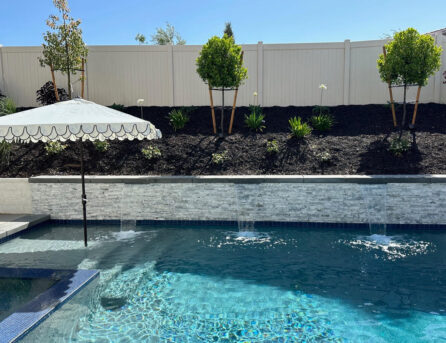
A backyard pool is more than just a place to cool off on hot summer days—it can be the centerpiece of your social gatherings. With the latest trends in pool design and landscaping, you can create a stunning space that’s perfect for entertaining guests year-round. Whether you’re hosting a casual barbecue or an elegant evening soirée, these ideas will help you make the most of your backyard pool.
Latest Trends in Swimming Pool Design
Integrated Water Features:
From cascading waterfalls to sleek fountains, water features add both visual appeal and a soothing ambiance to your pool area. These elements not only create a luxurious vibe but also drown out background noise, making your space more tranquil and inviting.
Swim-Up Bars and Sunken Seating:
Swim-up bars and submerged seating areas are popular additions that bring a resort-like experience to your home. These features allow guests to enjoy drinks and snacks without ever leaving the water.
LED Lighting:
Illuminate your pool and backyard with vibrant LED lighting. Options like color-changing lights and underwater fixtures add drama and flair to evening gatherings, creating a magical atmosphere.
Outdoor Kitchens and Fire Features:
An outdoor kitchen with a built-in grill, refrigerator, and prep station makes entertaining seamless. Combine this with a fire pit or fireplace near your pool for added warmth and a cozy gathering spot.
Luxury Pool Surrounds:
Update your pool deck with the latest materials like natural stone, porcelain tiles, or stamped concrete. A beautifully designed pool deck enhances the overall look and provides a safe, slip-resistant surface for guests.
Eco-Friendly Pool Systems:
Modernize your pool with energy-efficient systems like efficient heaters, saltwater chlorinators, and automated pool covers. These upgrades not only reduce maintenance costs but also appeal to eco-conscious guests.
Landscaping and Privacy:
Work with professional landscape contractors to create lush greenery, privacy hedges, or tropical-inspired plants around your pool. Thoughtful landscaping provides shade, seclusion, and an aesthetically pleasing backdrop for gatherings.
Tips for Hosting the Perfect Pool Party
● Create Comfortable Lounging Areas: Include plenty of seating options like lounge chairs, outdoor sofas, and shaded cabanas to accommodate guests.
● Music and Entertainment: Set up waterproof speakers or an outdoor TV for background music or live sports events.
● Pool Games and Accessories: Stock up on floats, beach balls, and waterproof card games to keep the fun going.
● Ambiance: Use string lights, tiki torches, or candles to set the mood for evening events.
Partnering with the Right Professionals
Designing the perfect pool space for entertaining requires the expertise of skilled pool contractors. These professionals can help you customize your backyard, blending beauty with functionality to create an inviting oasis.
Ready to Transform Your Backyard?
Whether you’re looking to upgrade your current pool or start from scratch, the possibilities are endless. Our landscape contractors can turn your backyard into the ultimate destination for entertaining guests. With the right design and features, your pool can become the highlight of every gathering.
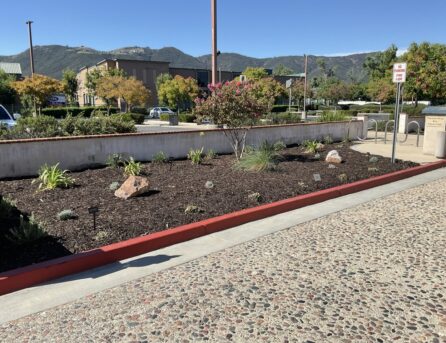
In today’s eco-conscious world, businesses are increasingly recognizing the importance of sustainability in all aspects of their operations—including landscaping. Sustainable landscaping is not only a way to reduce your environmental impact but also a smart financial decision. By adopting eco-friendly practices, businesses can create beautiful outdoor spaces that align with their values and benefit their bottom line.
Cost Savings Through Resource Efficiency
One of the primary advantages of sustainable commercial landscaping is the potential for significant cost savings. For example, water-efficient irrigation systems, such as drip irrigation, deliver water directly to plant roots, reducing waste and lowering water bills. California-friendly and drought-tolerant plants also require less water and maintenance, cutting down on expenses for both labor and resources.
Additionally, composting on-site can reduce the need for chemical fertilizers while diverting organic waste from landfills. Over time, these practices not only save money but also help preserve natural resources.
Environmental Benefits
Sustainable landscaping contributes to a healthier environment in several ways. California-friendly plants, for instance, support local ecosystems by providing food and habitat for pollinators like bees and butterflies. Green roofs and living walls can help reduce urban heat islands, lower building temperatures, and improve air quality.
Moreover, permeable paving systems allow rainwater to filter back into the ground, reducing stormwater runoff and minimizing the risk of flooding. These practices protect local waterways and reduce soil erosion, promoting a cleaner and healthier environment for the community.
Enhanced Brand Image
Sustainable landscaping demonstrates a commitment to environmental stewardship, which can enhance your brand’s reputation. Customers, employees, and partners increasingly prefer to associate with businesses that prioritize sustainability. An aesthetically pleasing and eco-friendly landscape not only attracts attention but also reflects positively on your company’s values.
Practical Examples of Sustainable Landscaping
- Rain Gardens: Capture and filter stormwater runoff.
- LED Outdoor Lighting: Uses less energy and lasts longer.
- Mulching: Retains soil moisture and suppresses weeds.
- Smart Irrigation Systems: Automatically adjust based on weather conditions.
Sustainable landscaping is more than just a trend—it’s an investment in the future of your business and the planet. By implementing eco-friendly practices, businesses can reduce costs, protect the environment, and create inviting spaces that leave a lasting impression.
Ready to transform your commercial property with sustainable landscaping? Our team of expert landscape designers in Temecula will help you create an eco-friendly space that aligns with your goals.
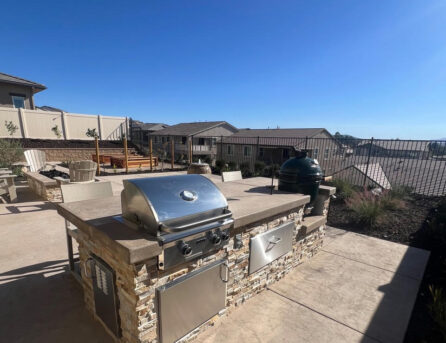
For culinary enthusiasts, outdoor kitchens are more than just backyard additions—they represent extensions of their passion for cooking and entertaining. A well-designed outdoor kitchen can transform your backyard into a gourmet haven, equipped to handle everything from intimate family dinners to elaborate feasts for friends. Taking these steps can help you design the ultimate outdoor kitchen for serious chefs.
1. Choose Professional-Grade Appliances
The heart of any chef’s kitchen lies in its equipment. Invest in high-quality appliances that can withstand outdoor conditions and meet the demands of serious cooking. Look for a grill with multiple burners, precise temperature controls, and a smoker box for added versatility. Consider adding a wood-fired pizza oven, a flat-top griddle, or even a rotisserie to expand your culinary repertoire.
2. Incorporate Ample Prep Space
Chefs need space to prep ingredients, so prioritize countertops made from a durable, weather-resistant material such as concrete. Ensure you have enough room for chopping, marinating, and assembling dishes. A dedicated prep sink with hot and cold water will make cleanup and ingredient washing more convenient.
3. Add Storage Solutions
Outdoor kitchens often lack the built-in storage of indoor kitchens, but that doesn’t mean they can’t be efficient. Include cabinets and drawers made from stainless steel to store utensils, pots, pans, and other essentials. Presentation is everything, so stock your outdoor kitchen with specialty items such as charcuterie boards, cheese knives, and cocktail glasses. Consider adding a pantry-style storage solution for non-perishables and spices.
4. Optimize the Layout for Workflow
Design your outdoor kitchen with the work triangle in mind: place the grill, prep area, and refrigerator in a logical, easy-to-navigate layout. L-shaped and U-shaped configurations are particularly effective for creating a functional flow.
5. Don’t Skimp on Utilities
Serious chefs need power and water to work efficiently. Install plenty of electrical outlets for small appliances like mixers and blenders, and ensure your outdoor kitchen has proper lighting for nighttime cooking.
6. Include a Beverage Station
Add a beverage fridge, ice maker, or even a bar area to keep guests entertained while you cook. Stock your bar area with all of the essentials, and consider a wine refrigerator to keep bottles chilled at the ideal temperature. It allows for social interaction without disrupting your workflow.
7. Protect Your Investment
An outdoor kitchen for a serious chef isn’t cheap, so protect it with proper shading and weatherproof covers. Pergolas, awnings, or even built-in structures can shield appliances and countertops from the elements.
Elevate Your Outdoor Cooking Game
A well-designed outdoor kitchen can take your culinary skills to the next level and create unforgettable experiences for your family and guests. Ready to transform your backyard into a chef’s paradise? Contact our outdoor kitchen design experts, and we’ll discuss your dreams and help you create a space tailored to your cooking style and goals.
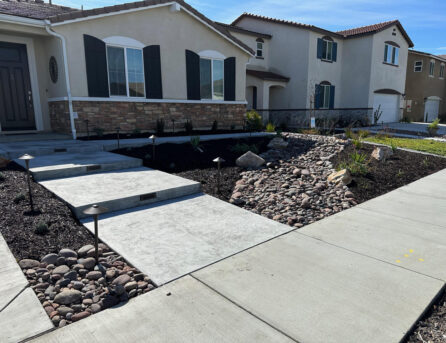
In regions where water conservation is essential, transitioning from a traditional lawn to drought-tolerant landscaping is a smart move. Not only does it reduce water usage, but it also lowers maintenance costs while creating a visually stunning and eco-friendly outdoor space. This step-by-step guide will help you make the switch.
1. Assess Your Current Landscape
Begin by evaluating the condition of your existing lawn. Identify areas with heavy sunlight, shade, and high foot traffic, as this will determine the best drought-tolerant alternatives to implement.
2. Remove the Existing Grass
There are several methods to remove your lawn:
- Sheet Mulching: Lay down cardboard or newspaper over the grass and cover it with mulch. This smothers the grass and enriches the soil as it decomposes.
- Sod Cutter: For faster results, rent a sod cutter to physically remove the grass.
- Solarization: Cover the grass with clear plastic to trap heat and kill the grass and weeds below.
Choose the method that best suits your timeline and budget.
3. Improve the Soil
Once the grass is removed, prepare the soil. Loosen compacted areas and amend the soil with compost to improve drainage and provide nutrients for new plants. This is particularly important if you plan to introduce drought-resistant vegetation.
4. Plan Your Design
Create a landscape plan that incorporates drought-tolerant elements such as:
- California-Friendly Plants: These are adapted to your climate and require minimal water.
- Succulents and Cacti: Ideal for arid environments, these plants add texture and variety.
- Artificial Turf: A low-maintenance option for areas where you still want the look of grass.
- Gravel or Decomposed Granite: Use these materials for pathways or open spaces.
Consider layering plants by height and grouping them based on water needs to maximize efficiency.
5. Install a Drip Irrigation System
Ditch traditional sprinklers in favor of a drip irrigation system, which delivers water directly to plant roots and minimizes evaporation.
6. Add Mulch and Hardscaping
Apply a layer of mulch around plants to retain moisture, regulate soil temperature, and reduce weed growth. Incorporate hardscaping features like stone pathways, decorative boulders, or raised planters for added visual appeal.
7. Maintain and Monitor
Even drought-tolerant landscapes need some care. Regularly check your irrigation system, prune plants as needed, and refresh mulch periodically.
The Benefits Are Clear
Converting your traditional lawn to a drought-tolerant landscape simplifies lawn maintenance by conserving water, enhancing your property’s beauty, and reducing upkeep. It’s an investment in sustainability and long-term cost savings.
Ready to make the switch? Contact our landscaping team for professional guidance and personalized designs that transform your outdoor space into a drought-resistant oasis.

Designing an outdoor space involves a balance between two key elements: hardscape and softscape. Understanding the difference between these two components is essential for creating a functional, aesthetically pleasing, and harmonious landscape. Let’s explore what each term means and how they work together.
What is Hardscape?
Hardscape refers to the “hard,” non-living elements of a landscape. These features are usually structural and add definition, functionality, and permanence to your outdoor space. Examples of hardscape include:
- Patios and Decks: Perfect for outdoor seating and entertainment.
- Walkways and Driveways: Provide safe, durable paths throughout your property.
- Retaining Walls: Useful for controlling erosion and adding visual interest.
- Water Features: Such as fountains and ponds, adding tranquility to the space.
- Fire Pits and Outdoor Kitchens: Elevate your space for hosting gatherings.
Hardscape elements are typically constructed with materials like stone, concrete, wood, metal, or brick. These features create the structure and foundation of your landscape and often require professional installation for longevity and safety.
What is Softscape?
Softscapes include the “soft,” living elements of a landscape. These include all the greenery and natural features that bring life and beauty to the design. Common examples of softscape are:
- Plants and Flowers: From colorful blooms to shade-providing trees.
- Grass and Lawns: A classic option for softening the overall appearance.
- Shrubs and Bushes: Add texture and depth to the landscape.
- Garden Beds: Perfect for vegetables, herbs, or ornamental plants.
Softscape elements can change over time with the seasons, growth, and maintenance. They add vibrancy, movement, and natural beauty to your outdoor space.
Finding the Perfect Balance
While hardscape provides structure and functionality, softscape introduces color, softness, and a natural feel. The key to a successful landscape design is balancing these elements. A yard that’s too heavy on hardscape may feel cold and uninviting, while a space that relies only on softscape may lack usability.
Let’s Design Your Dream Outdoor Space
Ready to create an outdoor area that reflects your style and meets your goals? Our professional landscape designers in Temecula specialize in combining hardscape and softscape elements to achieve the perfect balance. Contact us to start planning your ideal outdoor retreat!
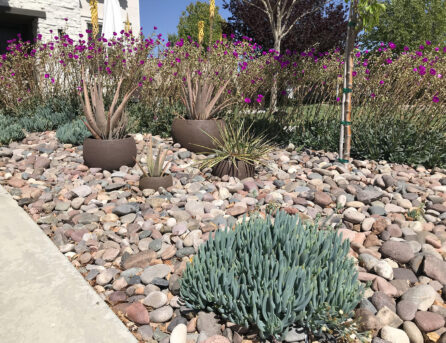
As water conservation becomes increasingly important, many homeowners are turning to drought-tolerant landscaping to save water and reduce their bills. Creating a yard that uses less water doesn’t mean sacrificing beauty. In fact, with the right approach, a drought-tolerant yard can be lush, colorful, and low-maintenance.
1. Choose Native Plants
One of the most effective ways to reduce water usage is by selecting native plants. These plants are naturally adapted to your region’s climate and typically require less water to thrive. Look for drought-tolerant options such as succulents, lavender, or ornamental grasses that can withstand dry conditions.
2. Group Plants with Similar Water Needs
Incorporate the concept of “hydrozoning” into your landscaping design. Group plants with similar water needs together, so you’re not overwatering low-water plants to satisfy the needs of those that require more hydration if you aren’t utilizing a drip system.
3. Install a Drip Irrigation System
Instead of using sprinklers, consider installing a drip irrigation system. These systems deliver water directly to the roots of your plants, reducing evaporation and runoff. This targeted watering approach is more efficient and can significantly lower your water bill.
4. Use Mulch
Mulch is a powerful tool in drought-tolerant landscaping. By applying a thick layer of organic mulch around your plants, you can help retain moisture, reduce evaporation, and prevent weed growth. Mulch also adds nutrients to the soil as it decomposes.
5. Replace Grass with Hardscaping
Traditional grass lawns are notorious for consuming large amounts of water. Replacing some or all of your lawn with hardscaping—such as gravel, stone pathways, or drought-resistant ground covers—can drastically reduce your yard’s water consumption.
Ready to make the switch to a more eco-friendly and low-maintenance lawn? Call our landscapers in Temecula today! By making a few smart adjustments, you can create a beautiful, drought-tolerant landscape while significantly lowering your water bill.
